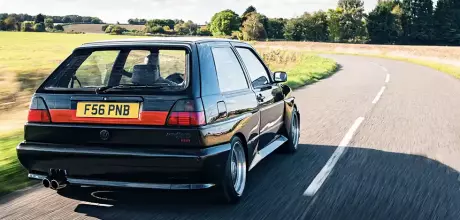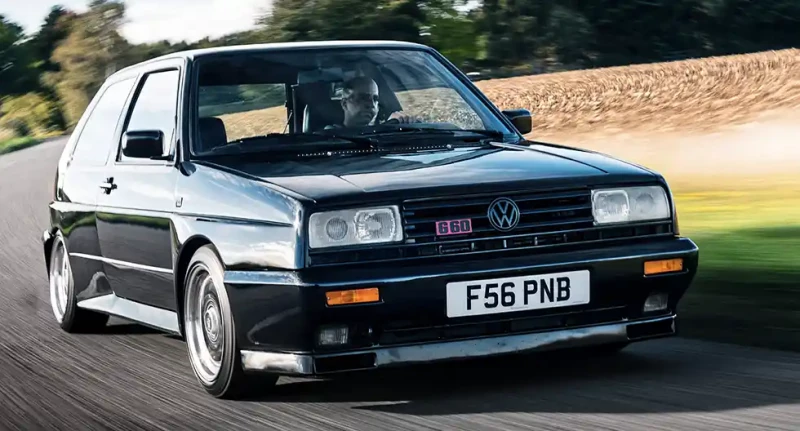Buying guide Volkswagen Golf MkII 1983-1992 Type 19E-1G1

Volkswagen Golf MkII From dependable bargain everyman classic to hot hatches and homologation specials, there’s a MkII Golf for everyone – for now.
Words CHRIS RANDLE & CHRIS HOPE
Photography BAUER ARCHIVE
The Golf GTi to buy now
From entry classic to ballistic hot hatch, there’s a MkII Golf for you
Buying Guide From classic runaround to homologation special: the VW Golf MkII

Purists may not want to hear it, but Volkswagen’s MkII Golf is a better car than the MkI – as well as a bargain. Simple evolution ensures it, and yet unlike flabbier later Golfs the second-generation car lost nothing of the original’s appeal. It’s better-built, more practical and shares largely the same engine range. Herbert Schäfer’s square-cut styling is clearly in the same idiom as Giorgetto Giugiaro’s MkI inside and out too. They always looked a bit older than they actually were, accelerating their classic appeal nowadays.
‘There are still MkIIs in daily use – and with that comes secondhand, rather than classic pricing’
And yet unlike the MkI, you won’t suffer to own it. It resists rot far more effectively, parts are easier to come by for it than both its predecessor MkI and, paradoxically, successor MkIII. And it’s cheaper too – a lot cheaper. While sellers are chancing premium asking prices even for basic rare-survivor MkI Golfs, there are still MkIIs in daily use. And with that comes second-hand, rather than classic pricing.
Admittedly if you fancy yourself a GTI or superrare Rallye variant it’s a different story, but classics don’t come much more classless than the MkII Golf. Here’s what you need to know if you fancy a topquality slice of Eighties Germany.
Which is which?
- Introduced in September 1983, the MkII Volkswagen Golf initially came with a choice of 1.3- and 1.6-litre four-cylinder petrol and diesel engines, plus a 1.6-litre turbodiesel, and four trim levels: basic C, then midrange CL and GL, with the rare luxury-trim Carat at the top of the range.
- The Golf GTI reappeared in 1985 after the last examples of the MkI GTIs had been sold, carrying over the 110bhp 1.8-litre Bosch K-Jetronic four-cylinder engine from its lauded predecessor.
- The Golf Driver, combining the GTI’s bodykit with the standard carburetted engines, appeared as a special edition alongside the sportier car.
- A four-wheel drive Golf Synchro, engineered by Steyr-Puch and powered by a detuned 90bhp version of the GTI engine, went on sale in February 1986.
- The Golf GTI 16v, with a new twin-cam cylinder head yielding 137bhp, supplemented the ‘basic’ eight-valve GTI from late 1986.
- A 160bhp supercharged G60, the name signifying the use of VW’s G-Lader supercharger, topped the GTI range from 1988. It was discontinued along with the rest of the MkII Golf range in 1991 in anticipation of new EEC emissions regulations.
- The Golf Rallye, Volkswagen’s answer to the Lancia Delta Integrale, was built in 1989 as a 5000-example Group A rally homologation special. It combined the GTI G60 supercharged engine with the four-wheel drive system of the Synchro. The three-door-only bodywork was heavily reworked, with box-blistered wheelarches and square Jetta-sourced headlights.
Bodywork
The Golf MkII is still a fairly common sight on today’s roads – proof that as far as rust resistance goes, these cars are above par. This is especially true of the earlier (pre-1990) examples, which were manufactured from higher-quality steel than the MkI shells. However, you’ll still need to inspect several important areas thoroughly. First, check the sills for any signs of rot or shoddy repair – addressing this could run to £1000 per side. You’ll also need to check the state of the wheelarches, plus the windscreen surround which is a difficult area to repair correctly and correspondingly expensive. If it’s a case of so far so good, move on to the suspension top mounts, front and rear, and check for signs of fatigue. If these need replacing, bank on £150 parts and £200-£300 in labour costs per rusty corner.
Water ingress can be an issue for Golf MkIIs. You’ll need to open both front doors and check the rubbers along the A-posts. If these have seen better days, you’ll need to lift the carpets and check the state of the floorpans. The same goes for the boot carpet too; the rear hatch often rots as water can collect – usually below the wiper arm, around the boot catch. Although replacement tailgates are readily available, if you’ve got a damp rear carpet, if could be bad news for the spare wheel well. Pattern parts are unavailable for this, so fabrication is needed and will be in excess of £500 to sort. If it’s just a carpet that needs replacing, a full set weighs in at £240.
Engine and gearbox
The range of four-pot VAG engines are all capable of lasting interstellar mileages, but only as long as they’ve been properly serviced and maintained. Ideally seek out an example that has been treated to oil and filter changers every 5000 to 6000 miles, backed up with receipts in the history book. Watch for clouds of blue smoke on start up and on the overrun, a tell-tale sign of worn valve guides or valvestem oil seal failures, both of which will require cylinder head work. Also find out when the cambelt was last changed; it needs replacing every 60,000 miles or four years, whichever comes first. Given that it can be done within an hour with the engine in-situ for less than £100, missed cambelt changes are a sign of neglectful ownership. A new engine or rebuilt original will cost around £4000.
Have a feel inside the fuel filler neck to check if it crumbles under your fingers. Any rot will drop into the tank and, if left unchecked, can find its way into the fuel system. The result is poor running, requiring a filter change at the very least. The fuel distributor and injectors (GTI) are also likely to have been damaged if the fuel has been contaminated. If the neck is new or recently repaired, you’ll also need to find out when the tank was last inspected. The good news is that it’s plastic so won’t corrode.
Non-GTIs were usually fitted with a Pierburg carburettor, and its auto choke can be problematic as it ages and its bimetallic strip sticks. It’s best to replace it with an aftermarket manual-choke Weber. One issue affecting the eight-valve engines concerns the oil pump, which has a habit of blowing its pressure relief valve, and should be changed at 100,000 miles. Upgrading with the sturdier item used in the 16-valve engine costs around £150.
Standard exhaust pipes rust, but you can replace your stock GTI exhaust backbox with a stainless steel version from around £250, or a complete Milltek Classic system is about £1200.
No gearbox is indestructible, but the five-speed units in the MkII will take a beating before wearing out. Commonly, it’s a second-gear crunch you need to be wary of. Fresh synthetic gear oil might help delay a rebuild, but ultimately this is the only solution. If the Golf you’re looking at has been thrashed then the clutch will highlight the extent of such abuse. The 16v GTI in particular can suffer wear, because of the inevitably higher stresses from the increased power and higher rev band. Given the Golf’s ubiquity, second-hand gearboxes can be found for as little as £150 but they may be just as worn as what you’re replacing. Reconditioned units cost around £1200 including fitting at a specialist.
Brakes and steering
The MkII GTI got all-round disc brakes, ventilated at the front and solid at the rear, and the calipers at the back have a terrible reputation for seizing. According to a number of specialists, replacements from a MkIII Golf are recommended. An upgrade kit from Heritage Parts Centre prevents the problem recurring, and includes the special braided conversion hoses required to run the later assembly from the MkII’s braking system. These are also available separately from Goodridge for £50. Braking performance can be improved with 280mm front discs from the G60. Calipers, discs and pads are all available new from Heritage Parts Centre but you’ll need to source used caliper carriers. Kits are around £100. The steering should feel accurate and precise on the move. If not, it’s most likely the mounting bushes rather than the rack itself that need replacing.
Interior and electrics
Whether seats are lined in cloth or leather, you can expect the usual scuffs and side-bolster wear and tear, especially on high-mileage cars. Check for electrical problems – the MFA (multi-functional annunciator) may not work on all its settings – so cycle through them all by pressing the button at the end of the right-hand column stalk. Faulty modes are often cured with a cheap sensor replacement.
Then there are heater motor and the matrix problems; check that the heater fan operates on all three speeds and there are no puddles of coolant in the front passenger footwell or steam when heat is engaged. Heater matrix spares are readily available and cheap from VW Heritage, but replacing them entails dash removal and large labour bills.
What to pay
- Running but scruffy Cs/CLs can be had for as little as £1000.
- Drivers have a cult following: mint ones can fetch £5000.
- £4500k buys a usable 8v GTI, with well lookedafter, unmodified examples fetching £7000 and rising.
- GTI 16vs start where 8vs tail off, rising to £14k for the best – although the UK auction record is more than twice that, admittedly for a barely used timewarp example.
- If you want a Synchro, G60 or Rallye, you’re best off looking in Germany, where most were sold – and be prepared to spend upwards of £16k.

Rallyes are rare, but MkII GTIs are now outliving MkIIIs. Interior hardwearing – but check for leaks and damp Dependable engineering, even when supercharged Switchgear is helpfully available from VW Heritage. Dependable, plentiful and well-built, but you should still check everything carefully. Rallyes are rare, but MkII GTIs are now outliving MkIIIs.

